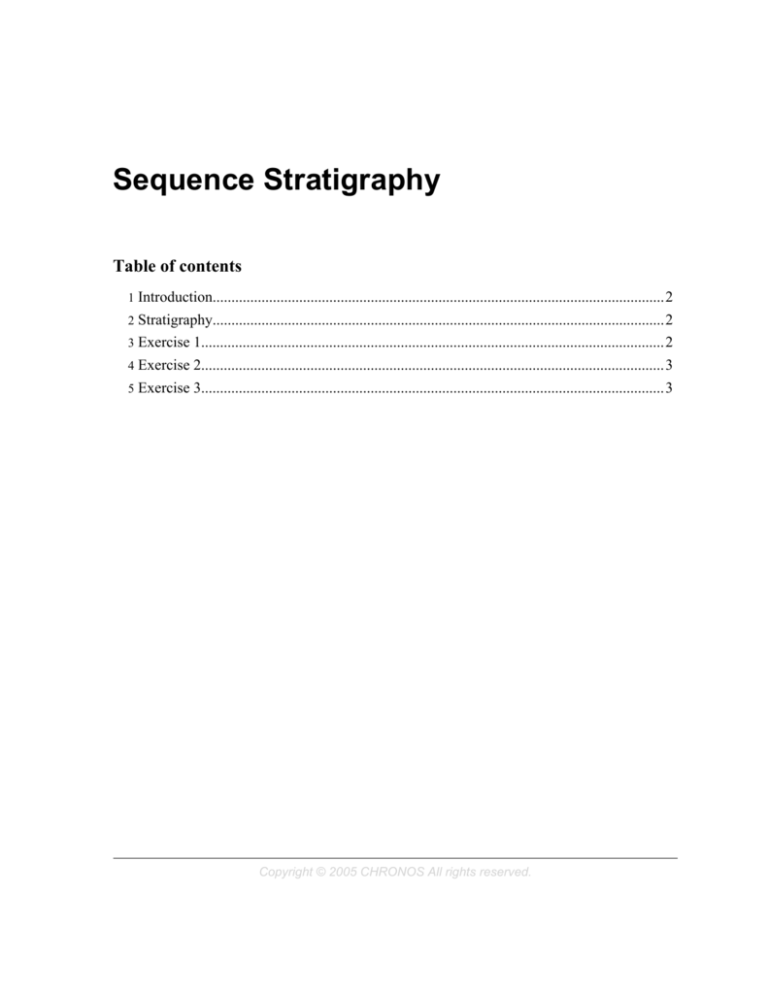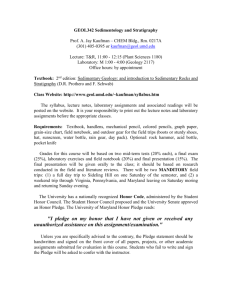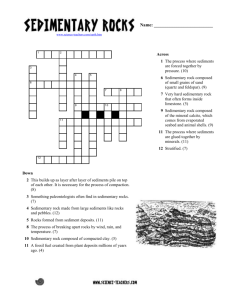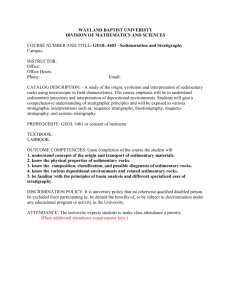
Sequence Stratigraphy
Table of contents
1
Introduction........................................................................................................................2
2
Stratigraphy........................................................................................................................2
3
Exercise 1...........................................................................................................................2
4
Exercise 2...........................................................................................................................3
5
Exercise 3...........................................................................................................................3
Copyright © 2005 CHRONOS All rights reserved.
Sequence Stratigraphy
These exercises have been adapted from modules developed by the Department of Geology,
University of South Carolina.
1. Introduction
Investigating sequence stratigraphy in a rock outcrop can be an exciting hands-on exercise.
Even in the absence of a good sequence of rocks to observe, sequence stratigraphy exercises
can still be applied. Below are three exercises based on data collected from an outcrop called
the "Book Cliffs" of the Mesa Verde Group, located on the Colorado-Utah border and
described by Van Wagoner (1995).
The Book Cliff sections serve as good models for understanding sequence stratigraphy: they
are well exposed; they are comprised of clastic sediments deposited in a prograding wedge of
sands and shales; little tectonic deformation occured as a result of their uplift and the Book
Cliffs include a variety of depositional systems which occur with a high frequency.
2. Stratigraphy
The Book Cliff escarpment exposes a large prograding clastic wedge of sands and shales.
This section was uplifted following the Cretaceous, exposing the following sedimentary
settings: coastal plain, foreshore and upper shoreface, lower shoreface, lower
shoreface-offshore shelf transition zone, and offshore shelf.
The sedimentary logs serve as convenient representations of the rock face and the
sedimentary details of the sections within. This makes identification of parasequences easy.
Note that finer grained sedimentary rocks of clay and silt-sized particles occur at the base of
these parasequences, indicating deeper waters, while coarse grained sediments (indicating
shallow water) occur at the top of parasequences. Furthermore, the parasequence boundaries
represent abrupt changes from sea level falls to sea level rises.
3. Exercise 1
The goal is to identify parasequences from one of the Book Cliffs' sedimentary logs (click
here to view). Print out the image and glance up and down the sedimentary log. You will
notice changes in the sedimentary structures, like trough-cross beds underlain by
hummocky/current-rippled beds, then planar beds, then trough-cut beds again.
Try writing the name of the sedimentary structure next to the its corresponding symbol on the
sedimentary log to become good at recognizing structural changes in the rock. These changes
preserve a record corresponding to a particular sedimentary setting. Correlate them using
table 1 and remember that the boundaries between sedimentary settings (in this case,
parasequences) at the Book Cliffs are clearly defined by the abrupt transition from fine
grained sediments to coarser grained sediments (wide sections on the sedimentary log
Page 2
Copyright © 2005 CHRONOS All rights reserved.
Sequence Stratigraphy
indicate coarser grained sediments while narrow sections indicate finer grained sediments).
Next, outline each parasequence by drawing an arrow or triangle next to it where the base
corresponds to the shallow water and the apex corresponds to the deep water.
Now, take a mental step back and realize that these parasequences correspond to changes in
sea level experienced at the same geographical location. Envision how the shoreline
advanced and retreated and write down a sentence describing the overall movement of the
shoreline at this location. Was the shore advancing seaward or retreating landward? Check
your findings against the solution.
4. Exercise 2
In this assignment, just as before, you will identify and mark the sedimentary structures and
the settings they correspond to. However, there is the additional task of correlating each
sedimentary log to each other. Notice that the log from exercise 1 (Kennilworth) is in the
middle of this figure. Print this out and simply transfer over your interpretations. Once you
have identified the settings in the new sedimentary logs you should take another mental step
back and try picturing these sedimentary logs as slits in a fence through which you can see
the Book Cliffs. You cannot see the part of the cliffs obstructed by the fence but you know it
is there and that some or most of these sedimentary settings are conected from one visible
section to the next (however, some sedimentary settings disappear between sediemntary
logs).
Use colors to connect the sedimentary settings across the three logs. Those settings that are
not continuous should taper to a point (i.e. they should be represented by a colored triangle
since it is not known where they end but it is known that they are not continuous). Check
your findings against the solution.
5. Exercise 3
This exercise includes the same three sedimentary logs from exercise 2 plus 9 more. Here
you will correlate the sedimentary settings between the sedimentary logs to develop a
broader view of the Book Cliffs. Print out exercise 3 and follow the directions listed above.
Then, check your findings against the solution.
References:
USC Sequence Stratigraphy
Van Wagoner, J.C., 1995. Sequence stratigraphy and Marine to Nonmarine Facies
Architecture of Foreland Basin Strata, Book Cliffs, Utah, U.S.A. in J. C. Van Wagoner, and
G. T. Bertram, eds. Sequence Stratigraphy of Foreland Basin Deposits - Outcrop and
Subsurface Examples from the Cretaceous of North America: American Association of
Petroleum Geologists Memoir 64: 137-223.
Page 3
Copyright © 2005 CHRONOS All rights reserved.








